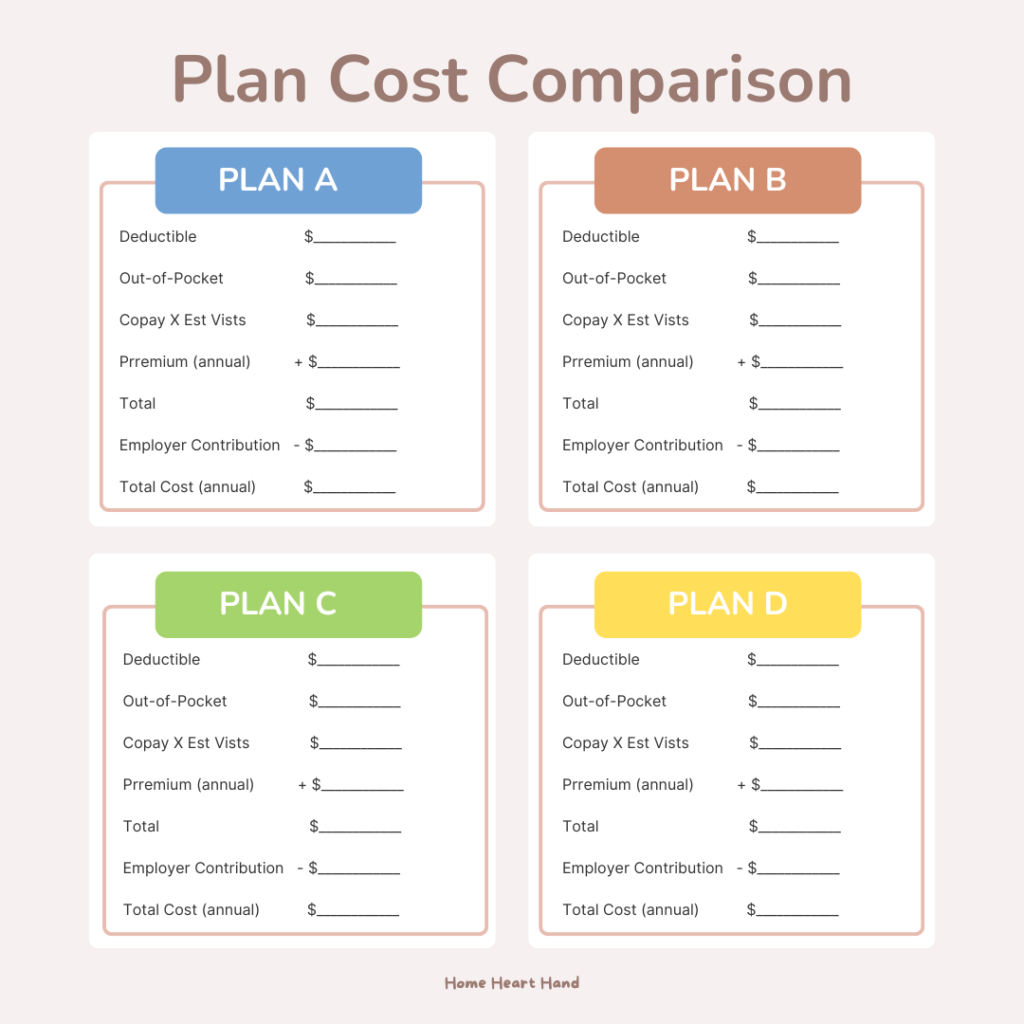While most of us are preparing for the holiday trifecta, we also have that dreaded open enrollment to tackle. Open enrollment is the short window of time (typically two weeks) per year when we can select benefits and make changes to any existing benefits. It also allows us to add or remove dependents or change our beneficiaries. This is also the time when employers unveil any changes they have made to the benefits. So, how do we survive open enrollment? Read on for tips and tricks we use to navigate this time of year.

What is Open Enrollment Season?
This is the time allotted by your employer to offer a selection of benefits to their employees. These benefits can include medical, dental, vision, and life insurance. It can also include pet insurance, gym memberships, or identity theft protection. This post will focus specifically on the medical benefits.
If you intend to select any of the offered benefits, you must do so during open enrollment. Benefits may be added outside of open enrollment but for only a handful of qualifying reasons. You may think that open enrollment season isn’t for you as long as you don’t want to make any plan changes. This may not be true depending upon the type of open enrollment your employer uses: active or passive.
With active enrollment, you must complete the process even if you don’t need to make any changes. If you don’t, you will lose the selections you currently have and may find yourself without any coverage in the next plan years. With passive enrollment, if you don’t make any changes you will simply keep the selections you currently have. To avoid losing benefits, make sure to ask which type your employer uses.
Open Enrollment Means Comparing Plans
While some employers only offer one plan type, many offer more than one. Typically, there will be two types of plans to choose from: high-deductible plans and copay plans. But these aren’t the only options. In fact, plans come in all shapes and sizes, so it is very important to fully understand what is being offered by your employer. This is a discussion best had with your HR department during open enrollment. Your prospective insurance plan may also be able to answer some questions. Here is an overview to get you started.
High-Deductible Plans
High-deductible plans, often called catastrophe plans, have large deductibles that apply before receiving benefits. The lower premiums can make these plans attractive, but it is important to have a plan for how to cover the out-of-pocket costs when you seek care from a provider.
The good news is these plans qualify for healthcare accounts that can assist with those costs. There are three types of healthcare accounts: health reimbursement accounts (HRAs), flexible spending accounts (FSAs), and health savings accounts (HSAs). Contributions to these accounts can be made by the employer, the employee, or both, and contributions can be made pre-tax.
Copay Plans
Copay plans are just as the name implies. With copay plans, providers collect copays (typically $20-$60) at the time of the visit, and then the plan pays the rest. These plans typically have the highest premiums but offer lower costs when seeking care. These plans tend to be a great option for families that will be seeking care regularly, as the upfront costs will be outweighed by the savings seen throughout the year.
Since most copays do not apply to the deductible, the full deductible may need to be met when seeking hospital services. However, the deductibles for copay plans are typically less than the deductibles seen with high-deductible plans.
Mixed Plans
Some plans combine the high-deductible plan with the copay plan. With these plans, members will need to either first meet the deductible and then the copays apply, or they will need to pay the copay to the provider and then the deductible will apply. These plans typically have much cheaper premiums, as the share the member pays when seeking care is much higher.
Minimal Essential Coverage Plans
With the dawn of the Affordable Care Act, employers found themselves needing to offer some type of medical benefits for their employees. Small to medium employers needed an option they and their employees could afford. Because of this, Minimum Essential Coverage (MEC) plans are now an option. These plans offer low and sometimes entirely employer-paid premiums, which can be attractive for younger, healthier employees. As the name implies, they also offer minimal coverage that meets the minimum coverage requirements outlined in the Affordable Care Act. All MEC plans cover preventive care, while they drastically limit or eliminate sick care.
No matter which plan you choose, taking the time to compare the options is essential. You will be locked into the decision for the full plan year. Picking the right plan may save your family from an unexpected medical bill.
Understand the Fine Print
My son took his first steps into the world of insurance, and he simply chose the cheapest premium at the suggestion of his HR personnel. While the cheapest premium may be the best option, it is always best to read the fine print. When he fell at the skatepark and ended up with some fractures, he also ended up with a pretty hefty bill.
Originally, he thought he had a copay plan. It sure did seem that way. The plan document listed urgent care visits had a $75 copay and specialist office visits had a $60 copay. While this was true, the copay didn’t apply until the $6,000 annual deductible was met. This meant that my son was on the hook for the entire bill minus the network discount. Needless to say, this was a huge shock and there was nothing to be done except hopefully choose a different plan at the next year’s open enrollment. When his next open enrollment did come around, it turned out that the plan he originally picked was the best one for him. The difference is, that he now knows how his plan works, so there shouldn’t be any more surprises.
Preventive Does Not Always Mean No Cost
Although most plans do state that preventive services are covered at no cost to the member, this is not always the case. Many people are shocked when they go for what they thought was a no-cost routine physical and end up with a very large bill.
No cost preventive benefits may be subject to the network status. While all plans are required to cover preventive services, if the provider is not participating in the plan’s network, the services may come with a bill.
For example, William’s regular primary care provider was not available, so he decided to see one of the other doctors in the practice. What William didn’t know is that the new provider does not participate in the plan network. Network participation is typically based on the individual provider and not the overall practice. William’s plan does cover preventive services with non-network providers, but those services first apply to the deductible. William will now have an unexpected bill.
Grandfathered Plans Vs Non-Grandfathered Plans
One of the best parts of the Affordable Care Act for a lot of people is that numerous services must be covered at no cost to the member. However, some plans are considered grandfathered. These plans were in place before March 23rd, 2010, which means they are not mandated to follow some of the requirements of the Affordable Care Act. If you have a grandfathered plan, preventive services may not be covered at no cost. It is best to read the plan carefully, to not be surprised with a bill.
Prescriptions May Apply to the Medical Deductible
Most insurance plans separate the medical and prescription deductibles. Typical plans will have a prescription copay applied even if the plan has a large medical deductible. However, some plans, typically high-deductible plans, combine the prescription and medical deductibles. This means that until the medical plan deductible is met, the full cost of any medications is the responsibility of the member. This can put quite a burden on the pocketbook if your plan has a large deductible to meet. Something as simple as an antibiotic could suddenly become unaffordable if you are not prepared.
The fastest way to an accidental unexpected bill is to miss reading the fine print in your benefit plan. Be prepared and fully read the plan to ensure it will cover your family without any surprises.
What is Included with the Office Visit?
Copay plans typically cover office visits at 100% after the copay. However, that may be the only thing the copay covers. If your provider orders tests or decides to remove that mole that is looking sketchy, you may be in for more than the copay. The best way to find this out is to look at the plan document or summary of benefits. This can usually be obtained from the HR department or sometimes from the insurance company. Review each benefit to determine what will apply to the copay and what may apply to the deductible.
Avoid Unexpected Denied Claims and Penalties
Every plan is very different and just as they have different deductibles, and out-of-pocket expenses, they can also have very different coverage. Take for instance the MEC plans we spoke about earlier. They typically do not cover labs and x-rays or any treatments the doctor may prescribe. Not being aware of these coverage limitations can cause large unwanted medical bills.
One of the positives to come out of the pandemic is the dawn of computer/ phone visits with our providers. Many providers are offering telehealth/ telemedicine appointments as a first-line service. However, there are many plans that do not cover this service outside of the plan’s vendor (Teledoc, UCM Digital, etc.). If your provider offers this service, make sure to check with your plan to see if the visit will be covered.
Most plans will have stipulations that require a pre-service notification. When we think of notification, we typically think of surgery or inpatient stays. However, some plans require pre-service notification for diagnostic imaging and tests, durable medical equipment, and injections (even ones performed during an office visit). Many plans will charge a penalty for non-notification which adds to the member costs. Penalties can range from a couple of hundred dollars to a percentage of the total cost of the visit. A 5 percent penalty on a $35,000 procedure would cost an additional $1,750 on top of any regular member costs.
Open Enrollment Means Figuring the Costs
Most people focus on the cost of the premium when choosing a plan. While this thinking does make enrollment season easier, it is flawed. It doesn’t take into consideration the other potential costs that may be incurred throughout the plan year such as copays, deductibles, coinsurance, and denied services. The lower premium plan may not be the cheaper plan if the out-of-pocket costs are too high. Let’s compare the two plans shown below.
When figuring the total annual costs, the deductible, total out-of-pocket, premiums (figured annually) and any copays (multiplied by the typical number of visits per year) need to be added. Then, if your employer contributes money to an HRA or FSA, this money should be subtracted from the total. The results will provide you with the total annual costs. If you typically only see the doctor for preventive services, you may not need to add much to the deductible and out-of-pocket amounts. Be aware that you should have a plan for covering these expenses in the event of an unexpected accident or illness. See our comparison tool below:

We use this tool to compare the plans from both our employers to see which one will fit our family’s needs the best.
Open enrollment season can seem frustrating and confusing. However, with a bit of education and planning, your family can successfully navigate this time of year.
